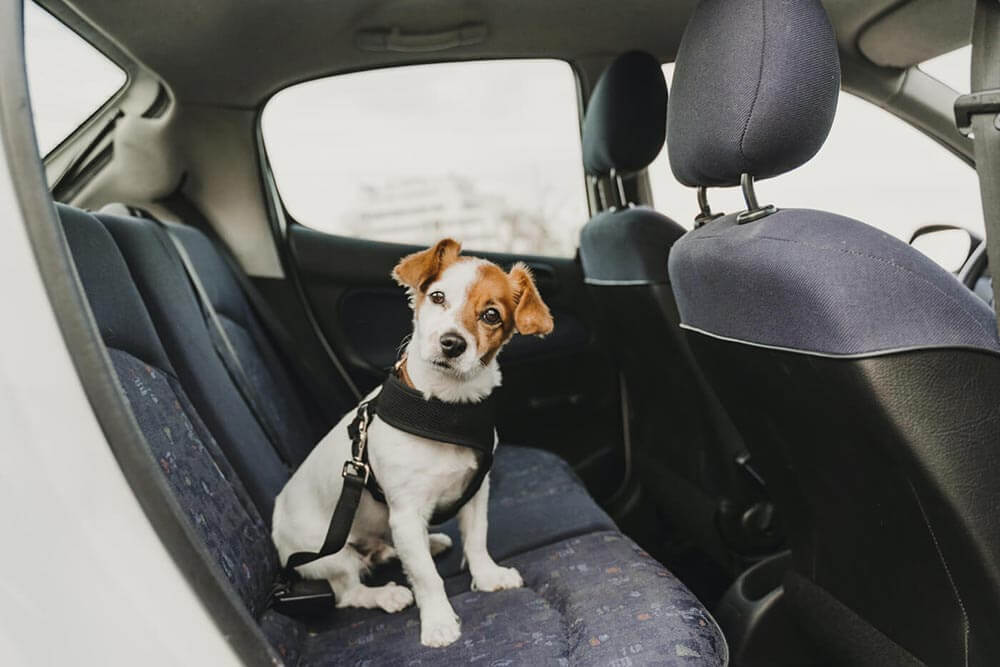With summer at our doorstep, the anticipation for road trips and cottage weekends is at its peak. Packing up and heading out of town with friends and family is a great way to experience new things and make lasting memories, and we don’t want to leave our furry family members out of the fun. But, summer road trips aren’t always as easy as jumping in the car and hitting the open road. Planning ahead and making some pre-trip preparations can help ensure that everyone stays safe and has a great time – pets included. We’ve rounded up some tips to help keep your pets happy and safe while travelling.
Safety tips for driving with your pet
- Know how your pet acts in the car. You know your pet best. If they’re on the nervous side or happen to get car sick, your vet can recommend different strategies to help them relax and enjoy the ride. This will also help you worry less about how your pet is doing and focus more on your driving. Sometimes all that’s needed is practice with car rides to get them more comfortable.
- Minimize distractions. We’re first to admit that we like to keep our pets close, but when it comes to the car, a bit of distance can be beneficial (and necessary). Allowing your pet to sit on your lap as you drive, or even in the passenger seat, can prevent you from keeping your full attention on the road. Even a slight moment of distraction has the possibility of resulting in trouble – for you, your pet and others on the road.
Distracted driving is a serious concern on today’s roads and is one of the more common traffic tickets that could impact your insurance rate. In fact, if your pet distracts you while driving, you can be charged with distracted driving. So, it’s best for everyone’s safety to have your pet sit in the back of your car.
- Pet seatbelts. Yes, they exist! There are many options on the market for seatbelts, crates, and other safety devices to help keep pets secure while driving. If you choose to use one, be sure to select the one that fits your pet and your car best. If it needs to be installed, it’s worth taking the time to do it properly.
- Don’t leave your pet in a parked vehicle. This has been said time and time again, and it’s worth repeating. It doesn’t take long for a car to heat up on a warm, sunny day. Leaving your pet in a parked vehicle could lead to an overheated canine or feline and can be easily avoided.
General safety tips for travelling with your pet
- Look for destinations that are pet-friendly. It’s a good idea to put some thought into where you’re going, as not everywhere is pet-friendly. Depending on the time of year, certain places, such as some beaches and parks, don’t allow pet visitors. Or, they may require Fido to stay on their leash. To keep everyone entertained, research pet-friendly activities and attractions in the areas you’re headed to before leaving. This also applies to stops along the way, which will give your pet a chance to get some fresh air, stretch their legs and do their business.
If you’re heading up to a cottage or planning for overnight accommodations, it’s best to check that they welcome pets before booking, and specifically if they permit your type of pet. Many accommodations will list in their descriptions if they are pet-friendly, but if it doesn’t say, don’t be afraid to ask. The hotel or cottage host can also let you know of any potential dangers to your pet during your stay that you should keep an eye open for.
- Make sure your pet has ID. Whether it’s a tag with your contact details and pet’s name, or a microchip (or both), if you happen to get separated from your pet, these will help make them easy for others to identify and get them back to you safely.
- Protect your pet from parasites. As the weather gets nicer, fleas, ticks and other parasites begin to make their way back onto the scene. Whether you’re staying close to home or venturing into the wilderness, you’ll want to take steps to protect your four-legged friend from parasites that could threaten their well-being. A visit to your vet can ensure your dog or cat is armed with the defense they need to keep these parasites at bay.
- Get pet insurance. If your pet causes property damage or injuries to someone else, this may be covered under the liability section of your home policy. But, if your pet is accidentally injured or gets sick, this is where pet insurance comes in handy. Pet insurance is there to help cover your pet’s medical costs in the event of an accident or illness, and our friends at Petsecure offer a selection of plans to match the needs of your fur babies. Depending on your policy, pet insurance can also help with preventative care, like flea control medication.
